Tibetan Places > Ba Lhagang > Nearby Sites Around Ba Lhagang
Sites Near Lhagang
Tashi Nunnery in Serkyi Gyelgo / བཀྲ་ཤིས་དགོན།
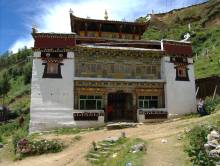 Assembly hall at nunnery
Assembly hall at nunnery
Serkyi Gyelgo is a thirty year old nunnery about 10-15 minutes drive from Lhagang. Originally the nunnery began as nuns aggregated around a well known retreatant named Tsempel a monk who had spent many years in a cave at this location. As the number of nuns at site increased, a community formed with Tsempel as their leader. Prior to passing away, Tsempel asked Drukdrak Lama (who was then a student at monastic school in Lhagang) to take over his responsibilities as leader of the community by acting as abbot. In the late 1990s, Drukdrak Lama (himself a reincarnate teacher) accepted Tsempel's request and has acted as abbot since then. Drukdrak Lama gives public Buddhist teachings to the community throughout the year and is highly regarded throughout much of Eastern Tibet.
The nunnery is actually a large complex of buildings which collectively constitute a small village known as Serkyi Gyelgo. The main buildings include a small assembly hall, a large monument consisting entirely of stones carved with Buddhist mantras, as well as residential buildings for the nuns and a building where Tibetan medicine in made. Where the road enters from the north is an outdoor assembly area where Drukdrak Lama teaches regularly. Adjacent to the large outdoor assembly area is a small hotel, shop, and restaurant.
Sitting above the village on the hillside are hundreds of white and pink prayer flags. Of significance on this same hillside is an area reserved for sky burials or funerals wherein a person's remains are fed to vultures and other birds. Just beyond the village-and in clear view of Zhara mountain's high, snowy peak-is a new monastic college and assembly hall. Despite the fact that most of the monastics in the community are nuns, this new monastic college is actually for monks (many of which are soon expected to arrive when the building is finished in 2007-2008). A college for female monastics is rumored to be in the plans for future construction.
The nunnery warmly welcomes outside visitors and indeed is well worth a visit if you are in Lhagang. For those interested in Buddhist studies, Drukdrak Lama offers public teachings according to the Nyingma tradition for three and a half months starting in October, as well as for a month in summer (June 15-July 15). In the 7th Tibetan month, the nunnery hosts a five-day festival that includes Tibetan operatic performances based on the life stories of Gesar and Milarepa. Travelers typically stay in the small hotel near the entrance of the village, paying about 20-30 RMB for a bed.
The nuns' main religious activities consist of reciting Buddhist texts-namely the Bardo Thödröl (a.k.a "The Tibetan Book of the Dead”)-and performing ritual fasting (Nyüngne), a practice in which one may eat only one meal every two days. Although always busy, the nuns and local community are more than accommodating and will ensure your time there will be fun and interesting.
Nézhi Monastery / གནས་བཞི་དགོན།
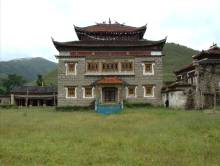 Main assembly hall at Nézhi Monastery
Main assembly hall at Nézhi Monastery
Thirty minutes away from Lhagang on the road from Dartsedo traveling from south to north is an old monastery known as Nézhi. A Nyingma monastery following associated Nyingthik tradition, Nézhi located between Lhagang and Rangakha in an area known as Bay-su.(1) Considered to be as old as the famous Lhagang monsatery, present day Nézhi is likely quite different than it was historically. In its past, the monastery had up to 60-70 monks in residence. That number has dwindled to about 15 in the present day, in large part due to government restrictions on the size of monasteries. No longer does the monastery host ritual dances and requests to allow academic Buddhist study have been rejected by the government, meaning that the monastery's primary role now is to perform a limited amount of rituals for the local community.
Getting to monastery is not difficult. The easiest solution is to stop on the way to or from Lhagang. If traveling by car, you will likely park outside its main gate or on the main road. The monastery is inset from the road and is most easily distinguished from a distance by its main assembly building which looks similar to most other monasteries in the area. The monastery is entered through a metal door at the front on the monastery complex. Inside the complex on the left is a series of stūpas, eight in total corresponding to a classical enumeration of different styles of stūpa. The main building is an assembly hall that sits adjacent to the stūpas and is noted for its bright, newly painted murals. Beyond this, the other building that may be of interest to travelers is a temple housing a large and well-maintained statue of Padmasambhava. Finally, to the right from the entrance of the monastery complex are residential houses for the monks.
Nézhi monastery's main affiliates are the nearby Senge monastery, as well as Lhagang, Pelri, and Chukmo monasteries to the north.
(1) As for the etymology of this name, we were give two alternate explanations based on two potential spellings: བལ་བཟོ and ཕག་གསོས . The first term is a reference to wool making. The second is a reference to raising pigs as livestock. Thus the valley could be translated as the “Wool-making” or “Pig-farm” valley.
Rilbu Monastery / རིལ་བུ་ཁང་། or རིལ་བུ་དགོན།
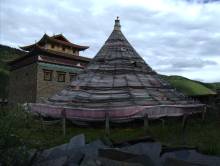 Distinctive prayer flags at Rilbu Monastery
Distinctive prayer flags at Rilbu Monastery
A Sakya monastery located just off the road in between Lhagang and Dartsedo in an area referred to as Shigan-da, just minutes north of Rangakha or about thirty minutes south of Lhagang. The monastery is distinguished by a large circular arrangement of prayer flags that are highly visible from the main road, as well as the series of large prayer wheels along the side of the monasatery complex. The monastery is known as “Rilbu-khang” owing to its history as a place where medicinal pills (Tibetan: རིལ་བུ) were made. The monastery consists of a shrine room devoted to Padmasambhava and an assembly hall that has been in the process of renovation in 2006-2007. Present day activity is very limited; most monks study at the affiliated parent monastery of Kabzhi (Tibetan: དཔལ་ས་སྐྱ་མི་ཉག་བཀའ་བཞི་དགོན), located two hours away on road toward Litang.
With so few monks, the main attractions at Rilbu monastery are its buildings. Like the nearby and Nézhi monastery just minutes up the road, Rilbu monastery's past was far more active and vibrant than today. Reportedly built at the same time as the famous Lhagang monastery (7th century) in Lhagang, Rilbu monastery has acted as a community center for ritual performances and other events. Today the monastery hosts no more than a handful of events, most of which correspond to visits from high-ranking lamas from Kabzhi monastery.
To get to Rilbu monastery from Lhagang, drive south toward Dartsedo for about 20 minutes. On your left, shortly before you arrive at the town of Rangakha, you will see the monastery's large circular assembly of white prayer flags. Parking on the side of the main road, enter the monastery at its main entrance situated in the direction of Rangakha.
Shédrüb Dargyé Ling Monastic School / ཤེས་སྒྲུབ་དར་རྒྱས་གླིང་།
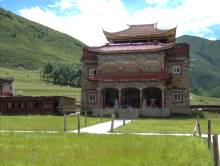 Assembly hall at Shédrüb Dargyé Ling
Assembly hall at Shédrüb Dargyé Ling
Shédrüb Dargyé Ling is a Sakya monastic school affiliated with Kabzhi monastery (Tibetan: དཔལ་ས་སྐྱ་མི་ཉག་བཀའ་བཞི་དགོན) in Rangakha. Founded around 2000, the monastery has 120 monks. The school's curriculum lasts ten years and consists of the study of traditional Buddhist topics, as well as English and Chinese. The school is run by a young generation of lamas interested in providing monks with an excellent traditional and modern education. Shédrüb Dargyé Ling looks over the town of Rangakha from the hillside. From Lhagang, the school is about a 30-40 minute drive to Rangakha plus an additional 10 minutes up the hill. (From Dartsedo, it is a two hour drive to Rangakha). In general, because the monks are engaging in focused study and Buddhist practice, tourists are not encouraged to visit; you may be turned away at the door.
Senge Monastery / སེང་གེ་དགོན་པ།
Senge monastery is set high on a hillside a fair distance away from the main road leading to Lhagang. By car from Lhagang, it is about a 40-50 minute trip-first south down the main road heading toward Dartsedo for about 20 minutes, followed by about a half hour drive on a dirt road the snakes back and up the hillside. Amongst the small monasteries in the area, Senge is one of the most vibrant and rich (although no less austere) in terms of the community of dedicated monks who live there.
The monastery is said to be upwards to 800 years old. Originally founded by Karma Pakshi, it was part of the Kagyu sect for much of its early history. Over a few centuries, the number of Kagyu monks at the monastery declined and the monastery was abandoned. About one to two centuries ago, the monastery was revived again, this time under the Nyingma lineage and has remained active ever since. Unlike the monastic colleges in the area, the monks at Senge monastery focus on meditation and ritual—not scholastic study. In particular, they focus on a body of “Great Perfection” or dzokchen liturgies and practices associated to the Nyinthik ("Heart Essence") tradition of the Nyingma sect.
Among the interesting features of the monastery are a large assembly hall, a shrine room housing a newly built stūpa, as well as numerous caves, rock formations, and historical relics immediately surrounding the monastery on the hillside.
Drankhar Monastery / བྲག་མཁར་དགོན་པ།
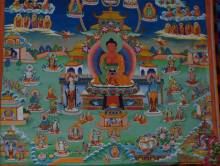 Mural at Drankhar monastery
Mural at Drankhar monastery
About an forty minute drive on a dirt road south of Lhagang is Drankhar, a small monastery situated in the quiet and remote valley of Nangkor. In all, there are no more than a handful of buildings that comprise the monastery which houses 80-90 monks. The monastery was named Drankhar because of the fact that it resides in a place that resembles a rocky (drak) fortress (khar).
Although originally part of the Kagyu sect, Drankhar monastery has come under influence of the Nyingmapas over the past few centuries. The monastery consists mainly of a single large assembly hall and shrine room. Unlike most monasteries, Drankhar was relatively unharmed during the Cultural Revolution.
As of 2007, the leader of the monastery (Tibetan: དགོན་དཔོན) is a lama known as Gelek Rinpoche.
To get there from Lhagang, you can either hike, ride horseback, or take a car. Drivers in Lhagang will go there at prices from 150-400 RMB, depending on the type of car, road-conditions, and how long you intend to stay in the area (renting a car for a day is usually no less than 400-500 RMB). Prices for traveling horseback have to be negotiated and can get fairly expensive. If possible, consult with the owner of your guest house or people at the Khampa Cultural Centre. Many guest-house owners are happy to help arrange a trip and will negotiate for a fair price. If you go, be sure to visit the nearby monastery of Bané about 30 minutes away.
Bané Monastery / བཱཿགནས་དགོན་པ།
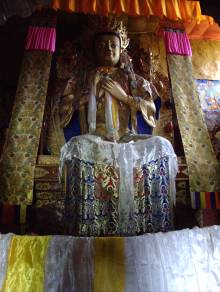 Maitreya statue at Bané Monastery
Maitreya statue at Bané Monastery
Located in Balang (Tibetan: བཱཿལང), a scenic valley about 50-60 minutes south-west of Lhagang by car, Bané (Tibetan: བཱཿ་གནས) is an isolated Nyingma monastery with about 60 monks in residence. Bané monastery's main affiliation is with the “Northern Treasure” (Tibetan: བྱང་གཏེར) lineage of Nyingma sect and, by extension, its parent monastery is Dorje Drak (རྡོ་རྗེ་བྲག་; with branches near Lhasa mainly, but also Dartsedo). The monastery consists of a main assembly hall and a Maitreya shrine room.
Like at many small monasteries, monks here typically do not engage in in-depth study of texts, but rather focus on ritual activities. Those who wish to study are sent north to Serta for training. As of 2007, the head lama is Pema Wangyal-also known as Bané Guzhok (Tibetan: བཱཿགནས་སྐུ་ཞོགས).
To get there from Lhagang, you can either hike, ride horseback, or take a car. Drivers in Lhagang will go there at prices from 150-400 RMB, depending on the type of car, road conditions, and how long you intend to stay in the area (renting a car for a day is usually no less than 400-500 RMB). Prices for traveling horseback have to be negotiated and can get fairly expensive. If possible, consult with the owner of your guest house or people at the Khampa Cultural Centre. Many guest-house owners are happy to help arrange a trip and will negotiate for a fair price. If you go, be sure to visit the nearby monastery of Drankar just a 30 minutes away.
Zhara Yumtso – The turquoise lake at Zhara mountain / བཞག་བྲ་གཡུ་མཚོ།
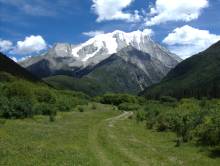 Path leading to Zhara Yumtso
Path leading to Zhara Yumtso
The area immediately around Zhara mountain offers a range of interesting places and things to explore by foot and horseback, including rivers, hot springs, and wild life. Particularly significant is Zhara Yumtso, a beautiful lake that sits at the base of Zhara on its eastern side. While higher in elevation than Lhagang, the hard part of Zhara Yumtso is not necessarily the hike winding up to the lake itself, but getting access to that area in general—either by car or on horse. By horse, the trip to Zhara Yumtso from Lhagang and back can take at least 3-4 days and is best arranged with the assistance of a reliable guide.
By contrast, a trip by car can be done in day. If you opt to drive, you can hire a car from Lhagang at prices starting anywhere from 350 RMB and up. The drive is about 2 to 2 and ½ hours one-way. It will take you north to the towns of Bamei and Garthar and then northeast for about 30-40 minutes toward Danba before turning off the highway onto a dirt road that leads to the backside of Zhara. If you go by car, be aware the road to Yumtso is rough; inclement weather renders the road unusable and most cars for hire in Lhagang are barely equipped for the journey even in good conditions. More significantly, be aware that the dirt road that leads to base of Zhara Yumtso is restricted and access is controlled by officials at an entrance gate. Depending on circumstances, officials may or may not permit you to enter or may charge a fee. It is best to consult with local tour experts in Lhagang or Bamei before trying to travel to Zhara by car.
Once at the base of Zhara, it is gradual and pleasant hike to the lake. At a casual pace, it takes no more than 2-3 hours to get there and about 2 hours back, making it a great destination for a day trip. Like much of Tibetan landscape, Yumtso is considered sacred. At the lake you may encounter locals hanging prayer flags or circumambulating around the lake. Once there, you will be able to get a close look at the glaciers on Zhara and the beautiful waterfall that they feed. For the adventurous, you may also ask the locals about the nearby hot springs a few hours away by foot.
Ralo Monastery / ར་ལུ་དགོན།
A half hour walk from Lhagang, Ralo monastery and village offer a nice glimpse of what many of the small, remote monasteries in the area are like. To get there from Lhagang, walk down the side road over the main bridge that crosses the river (heading south) and continue straight until you encounter a right-turn and another bridge. Cross that bridge and turn right on that dirt road (if you turn left you will arrive at Lhagang's Nyingma monastic college). Follow the dirt road back to the main river and then left -- past the new monastic college (on your left) and Chengresig mountain. The road curves left (away from the river) around the mountain and continues on for about 20 or 30 minutes to the village of Ralo. The walk is mostly flat as you make your way down the basin of the valley. During the summer, this trail be a good place to spot different types of wildlife. Upon arrival at Ralo, one of the main attractions is the assembly hall. As with many destinations near Lhagang, be alert for Tibetan guard-dogs as you pass by residential areas. In rural areas, dogs often are not chained down and will go after you if you get too close to their homes!
Pelri Monastery / དཔལ་རིས་དགོན།
Pelri Monastery is located about 60 minutes to the northwest of Lhagang by car in a scenic grassland area. Like Bané monastery, Pelri is associated is associated to the Northern Treasure tradition in the Nyingma school.
Dorakarmo / རྡོ་ར་དཀར་མོ
Dorakarmo is a small nomadic area 40 minutes to the east of Lhagang. Apart from being located in a scenic valley not far from Zhamo mountain, until recently travelers would have had little reason to notice or visit this location. These days Dorakarmo is gaining attention for the ambitious new elementary school started by Dorje Tashi Rinpoche that will soon host up to 2000 children from extremely low-income families in the area. With funding from Chinese patrons and a number of foreign philanthropic groups, the school will soon be home of several modernly equipped classrooms, administrative offices, and a library.
At present, there's little in Dorakarmo but the beginnings of the school, which itself is open only to administrators and visitors with an invitation to enter through its main gate. In the future, it is expected that this will area will become more accessible and open to foreign visitors, especially with the new airport near Kangding slated to be finished in 2008.